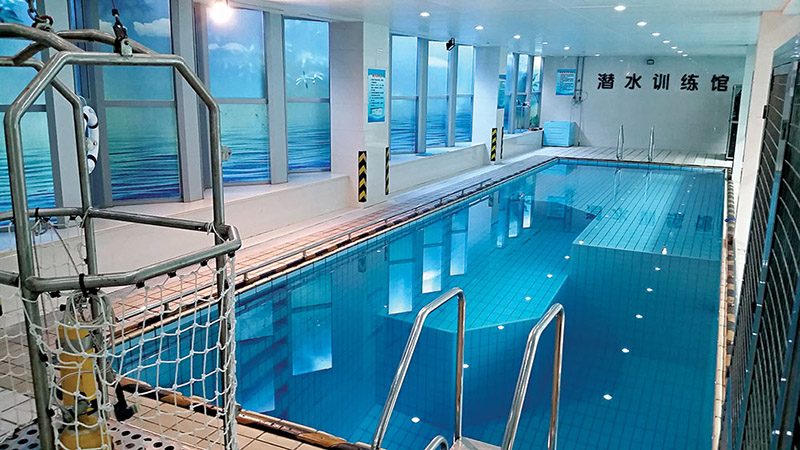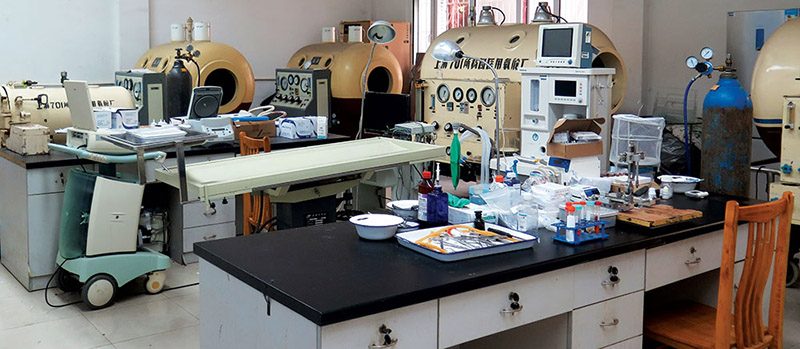Challenging the frontiers of decompression research
Recreational diving is becoming more popular in China every year. With about 500,000 dive certifications issued in 2018 alone, there is increasing need for dive physicians, treatment facilities and research. Weigang Xu, M.D., Ph.D., current director of the Department of Diving and Hyperbaric Medicine at the Military Medical University in Shanghai, is well-known in the field. He has worked as a dive physician since 1995; he received his doctorate in dive medicine in 2003 and became a professor in 2012. Head of the only organization in China eligible to train dive physicians for military, commercial and recreational diving, Dr. Xu has published more than 100 papers in domestic and international journals, authored 18 textbooks and monographs, and received numerous awards for his publications, teaching and research.
In almost all Chinese academic organizations in the field of diving and hyperbaric medicine, Xu is either chair, vice chair or a committee expert member, and he has organized national and international academic conferences on the subject. He has also mentored most doctoral fellows in dive medicine in China for the current and past several years.
Describing Xu’s research focus is a challenging task because his group has considered most aspects of current decompression theory. Staffed with a team of 10 researchers, his laboratory works on prevention and treatment of decompression sickness (DCS) on a cellular level as well as in animal models and human divers.
The effect of decompression on blood vessels (vascular endothelial function) has been observed for many years, but the mechanism of injury is still disputed. How did you investigate the underlying causes of endothelial dysfunction?
We conducted a series of experiments using strictly controlled DCS models and in vitro vascular bubble perfusion technique and proved that endothelial dysfunction following decompression is indeed linearly correlated to bubbles. However, there does not seem to be a measurable correlation with pressure or oxygen partial pressure in hyperbaric exposure.
Compared with common clinical diseases, the pathogenesis of DCS is distinct, with considerably fewer cases. The study on the etiology, prevention and treatment of DCS is therefore highly dependent on small animal models. What models did you find most practical for working on DCS?
Our current DCS small animal models are rats and rabbits. We are constantly improving these models to adapt to the research questions we ask. A strain of rats is usually easy to control, and the gene pool is generally very stable. A study of pathogenesis based on the rat DCS model is much more feasible, easy and cost effective than it could ever be in humans. Rabbits are of moderate body size, and their vasculature and anatomical features in eyes, ears and spinal cord are suitable for the study of microcirculation changes and the mechanism of spinal cord injury in DCS.

Humans are obviously not rodents, so it is not possible to translate these research findings directly to human physiology. To overcome this problem, you are also working with a swine model. What advantages does a swine model have?
In nonprimates, swine are probably most similar to humans in terms of gene level, anatomical structure and physiological characteristics. They are especially beneficial for studies involving pathogenesis of skin DCS. We systematically observed the development and evolution of DCS skin symptoms in swine, studied the relationship between skin lesions, central nervous system dysfunction and arterial bubbles, and analyzed the correlation between the amount of circulating bubbles, biochemical indicators and skin lesions. These results provided the necessary basis for the use of skin manifestation as a noninvasive evaluation tool for DCS.
How does this research translate to human physiology?
We currently develop decompression algorithms for different animals, which can be used not only to result in DCS with expected incidence rate but also to help increase the understanding of deduction rules between different decompression models and ultimately between animal models and human divers. We are developing new decompression profiles, prevention and treatment measures for DCS. This is basically a stepped research system starting with an initial effect evaluation in the rat model, progressing to effect and safety evaluation using the rabbit and concluding with the swine model. While not directly translatable, this system provides a solid basis for ongoing research in human divers.
To study the effect of bubbles on blood vessels in more detail, you have developed a new system for in vitro vascular bubble perfusion. What do you hope to achieve with this system?
The system can perfuse a segment of blood vessel using liquid with microbubbles at specific density and size as required. This process provides conditions for in-depth observation of the effect of bubbles on endothelial and vascular function. With this system we were also able to explore protective effects of different substances on vascular and endothelial lesions caused by the introduced bubbles.
What are your main targets when exploring the biomarkers of decompression stress?
We screen different molecules such as endothelin (sensors constricting blood vessels and increasing blood pressure), markers for oxidative stress (e.g., malondialdehyde) and adhesion molecules, which are involved in the interaction between blood vessel wall and immune cells (e.g., intercellular adhesion molecule 1, or ICAM-1). All these markers can reflect the severity of decompression stress, and we observed changes in these markers existing up to three to four days after experimental dives. We studied the time course of these stress markers as well as their correlation to bubble formation and were able to construct a retrieval table for the relationship between the level of each parameter and the amount of bubbles at different times after the onset of DCS symptoms. We accumulated the values of the parameters from rat, rabbit and swine models to complete the retrieval table.

These tables could have great potential to understand and mitigate decompression stress in human divers as well.
Precisely. We have also collected parameters such as these in divers with DCS with the goal of developing an index table that can evaluate their severity of decompression stress. The levels of endothelial biomarkers at different time points after diving might serve as simple yet sensitive parameters in the assessment of bubble load and decompression stress. This time course can provide necessary information about the onset and recovery of DCS endothelial injury.
A lot of research is focusing on preconditioning — things you can do before the dive to decrease decompression stress and the risk of DCS. What were the major findings from your work on nutrition and hyperbaric oxygen (HBO) preconditioning?
As for nutritional supplements, we worked with a rat and swine model to see whether escin (horse chestnut extract) used as an endothelial protection agent would reduce decompression stress. Escin showed the capacity to significantly reduce DCS occurrence and severity in the models. We published these promising results but have yet to do further investigations in human divers.
We also explored the effects of HBO preconditioning and found that a single exposure to HBO more than 10 hours before diving could effectively alleviate incidence and pathogenesis of DCS in rats. This outcome was associated with the induction of heat shock proteins (HSPs), which is another marker for oxidative stress. This preconditioning protection is also effective for in vitro neurons. HBO functions mostly via free radical induction, but the exact source of subcellular free radicals (reactive oxygen species, or ROS) has not been studied in depth. Through specific fluorescent ROS probes and inhibitors to ROS-generating pathways, we developed an algorithm that can evaluate the source of intracellular ROS under both hyperbaric hyperoxia and normal conditions.
We completed one study on HBO preconditioning in our swine DCS model, which further confirmed the involvement of HSPs in the pathogenesis of DCS. A trial comparing simulated (hyperbaric chamber) and real diving on human divers is currently underway.
Speaking of dive algorithms, what is your involvement in the optimization of dive tables?
To optimize the decompression tables currently in use and improve the efficiency and safety of dive operations in recreational and military divers, we have adapted decompression algorithms and decompression profiles. We developed and tested a new heliox dive table in more than 500 dives at sea. We are still working on an association study based on the observations from different animal models and studies with divers.
Can you tell us about the Expert System for Safe Diving and how it can be used?
The system covers various aspects of dive safety and health management, including operation plans, risk control, operation standards, process management, accident treatment, equipment management, personnel management and accident reporting. The system will play a significant role in the improvement of efficiency and safety for underwater operations.
As the team leader, I have been responsible for the medical support for saturation dive tests, heliox dive training and emergency dive operations for many years. This also led me to establish the Diving Occupational Health Committee to improve the health management and service for the dive industry. This committee drafted more than 10 industry norms that play an important role in dive-related occupational health administration in China today. Commercial and military diving has become very safe, but we still see numerous DCS cases in recreational divers.
Are you a diver?
I’ve been a diver since 1995, but between research, teaching, my regular exercise and active duty, it is hard for me to find the time to frequently get into the water. I am passionate about diving as a sport and am involved in developing a scuba training system and dive health service for China. We just established Treatment Alliance for DCS (TAD) to improve the comprehensive ability to treat dive-related diseases and provide help for occupational and recreational divers. I just finished the improvement of DCS treatment tables used in China to make them more feasible for hyperbaric physicians. I hope to continue supporting the growth of the sport in China.
© Alert Diver — Q2 2019